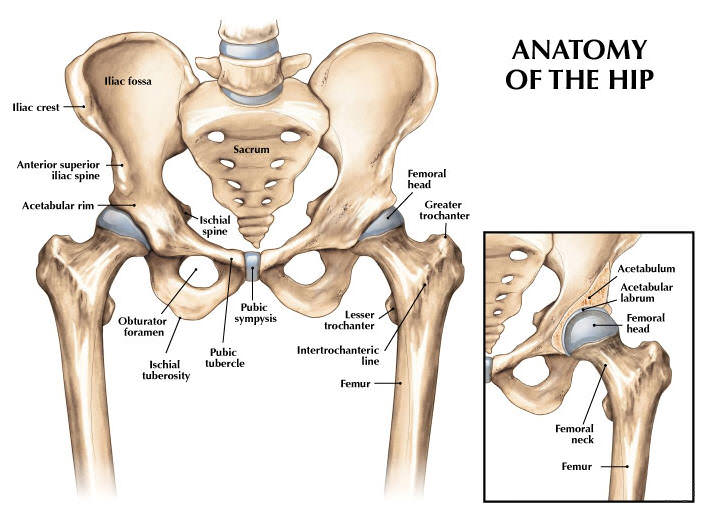Anatomically the hip joint is a precise structure in a particular place in the body. However, in common language “the hip” can include a wide area of the groin, outer abdomen, the side of the upper leg and the buttock. In this wide area there are many conditions that can lead to pain that is generally described as “hip pain” by most people.
True Hip Pain
Pain arising from the hip joint and the soft-tissue structures close to it tends to be felt in the crease of the groin at the top of the thigh and in the front of the thigh itself. It can be felt in other areas but these are the most common. Pain will often be worse on weight bearing and better at rest.
Typical true hip pain problems are:
- Osteoarthritis of the hip is the commonest condition, most prevalent in the elderly and if severe is treated with total hip replacement.
- Hip labral tears (damage to the cartilage ring around the hip joint) are hard to diagnose and need a specialist to confirm and operate on.
- Congenital hip problems (“clicky hips”), now referred to as hip dysplasia, developmental dysplasia of the hip or DDH, occur due to an abnormality of growth and development of the ball and socket of the hip joint.
- Slipped capital femoral epiphysis or SCFE, the upper growth plate of the thigh bone, occurs in children and adolescents.
Other conditions related to the hip area are:
- Greater trochanter pain syndrome, a hip bursitis previously called trochanteric bursitis
- Iliopsoas bursitis
- Ischial bursitis, weaver’s or tailor’s bottom
Lower Back Pain
Low back pain can be referred to anywhere in the buttocks and leg, so pain felt in the hip areas could be caused by a back problem.
Sacroiliac Joint Pain
The sacroiliac joints are large static, stable joints connecting the spine to the wings of the pelvis. They are known to be a source of pain and can refer pain around the pelvis.
Diagnosis Of Hip Pain
A physiotherapist will often make the initial diagnosis of a hip area pain. Physiotherapists will examine the back, sacroiliac joints and hips to narrow down the source of the pain to the responsible structures.
Physiotherapists use mobilisation techniques, muscle energy techniques, trigger point therapy, advice and exercises to manage hip problems.
References:
- Hip pain in adults. NHS Choices. http://www.nhs.uk/conditions/hip-pain-adults/Pages/Introduction.aspx
- Hip pain. Arthritis Research UK. http://www.arthritisresearchuk.org/arthritis-information/conditions/hip-pain.aspx
Last Review Date: 08-01-2020
Next Review Date: 07-01-2022

